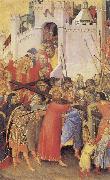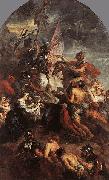
Oil On
Canvas, Real Flavor of Old Masters
|
Maurice Denis
|
|||
|
|
|||
| 1870-1943 French Maurice Denis Locations French painter, designer, printmaker and theorist. Although born in Normandy, Denis lived throughout his life in Saint-Germain-en-Laye, just west of Paris. He attended the Lycee Condorcet, Paris, where he met many of his future artistic contemporaries, then studied art simultaneously at the Ecole des Beaux-Arts and at the Academie Julian (1888-90). Through fellow student Paul Serusier, in 1888 he learnt of the innovative stylistic discoveries made that summer in Pont-Aven by Paul Gauguin and Emile Bernard. With Serusier and a number of like-minded contemporaries at the Academie Julian | |||
|
|
|||
| This artist (Maurice Denis) is not available now. | |||
|
|
|||
|
Simone Martini
|
|||
|
|
|||
| 1283-1344 Italian Simone Martini Locations He was a major figure in the development of early Italian painting and greatly influenced the development of the International Gothic style. It is thought that Martini was a pupil of Duccio di Buoninsegna, the leading Sienese painter of his time. His brother-in-law was the artist Lippo Memmi. Very little documentation survives regarding Simone's life, and many attributions are debated by art historians. Simone Martini died while in the service of the Papal court at Avignon in 1344. Simone was doubtlessly apprenticed from an early age, as would have been the normal practice. Among his first documented works is the Maest?? of 1315 in the Palazzo Pubblico in Siena. A copy of the work, executed shortly thereafter by Lippo Memmi in San Gimignano, testifies to the enduring influence Simone's prototypes would have on other artists throughout the fourteenth century. Perpetuating the Sienese tradition, Simone's style contrasted with the sobriety and monumentality of Florentine art, and is noted for its soft, stylized, decorative features, sinuosity of line, and unsurpassed courtly elegance. Simone's art owes much to French manuscript illumination and ivory carving: examples of such art were brought to Siena in the fourteenth century by means of the Via Francigena, a main pilgrimage and trade route from Northern Europe to Rome. Simone's major works include the Maest?? (1315) in the Palazzo Pubblico in Siena, St Louis of Toulouse Crowning the King at the Museo di Capodimonte in Naples (1317), the S. Caterina Polyptych in Pisa (1319) and the Annunciation and two Saints at the Uffizi in Florence (1333), as well as frescoes in the Chapel of St. Martin in the lower church of the Basilica of San Francesco d'Assisi. Francis Petrarch became friend with Simone while in Avignon, and two of his sonnets make reference to a portrait of Laura de Noves he supposedly painted for the poet. | |||
|
|
|||
|
|
The Road to Calvary new9/Simone Martini-948229.jpg Painting ID:: 33318 Visit European Gallery |
mk86 c.1315 Tempera on wood 29.5x20.5cm Paris,Musee National du Louvre | |
Height Width |
INS/CM |
||
|
X |
|
||
|
|
|||
|
Peter Paul Rubens
|
|||
|
|
|||
| Flemish Baroque Era Painter, 1577-1640 Peter Paul Rubens (June 28, 1577 ?C May 30, 1640) was a prolific seventeenth-century Flemish Baroque painter, and a proponent of an exuberant Baroque style that emphasized movement, color, and sensuality. He is well-known for his Counter-Reformation altarpieces, portraits, landscapes, and history paintings of mythological and allegorical subjects. In addition to running a large studio in Antwerp which produced paintings popular with nobility and art collectors throughout Europe, Rubens was a classically-educated humanist scholar, art collector, and diplomat who was knighted by both Philip IV, king of Spain, and Charles I, king of England. Rubens was a prolific artist. His commissioned works were mostly religious subjects, "history" paintings, which included mythological subjects, and hunt scenes. He painted portraits, especially of friends, and self-portraits, and in later life painted several landscapes. Rubens designed tapestries and prints, as well as his own house. He also oversaw the ephemeral decorations of the Joyous Entry into Antwerp by the Cardinal-Infante Ferdinand in 1635. His drawings are mostly extremely forceful but not detailed; he also made great use of oil sketches as preparatory studies. He was one of the last major artists to make consistent use of wooden panels as a support medium, even for very large works, but he used canvas as well, especially when the work needed to be sent a long distance. For altarpieces he sometimes painted on slate to reduce reflection problems. His fondness of painting full-figured women gave rise to the terms 'Rubensian' or 'Rubenesque' for plus-sized women. The term 'Rubensiaans' is also commonly used in Dutch to denote such women. | |||
|
|
|||
|
|
The Road to Calvary new24/Peter Paul Rubens-599464.jpg Painting ID:: 83528 Visit European Gallery |
Date between 1634(1634) and 1637(1637) Medium Oil on canvas, rounded at the top Dimensions Height: 569 cm (224 in). Width: 355 cm (139.8 in). cjr | |
Height Width |
INS/CM |
||
|
X |
|
||
|
|
|||
|
Giovanni Sodoma
|
|||
|
|
|||
| 1477-1549 Giovanni Sodoma Galleries | |||
|
|
|||
|
|
The Road to Calvary new24/Giovanni Sodoma-397875.jpg Painting ID:: 83574 Visit European Gallery |
Date ca. 1510(1510) Medium Oil on wood Dimensions Height: 36.5 cm (14.4 in). Width: 62 cm (24.4 in). cjr | |
Height Width |
INS/CM |
||
|
X |
|
||
|
|
|||









